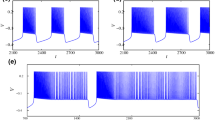Abstract
Despite the fact that the phenomenon of bursting activity is important for functioning of living neural networks, the mechanisms of its origin are still not clear. In this paper, we propose a new phenomenological model that can explain the mechanisms of the formation of bursting activity based on short-term synaptic plasticity, recurrent connections, and neuron–glial interactions. We show that neuron–glial interactions can induce bursting activity. The bifurcation scenarios of emergence of bursting activity are in the focus of the paper. Proposed study is important for understanding the complex dynamics of neural networks.



Similar content being viewed by others
References
R. Segev, I. Baruchi, E. Hulata, E. Ben-Jacob, Phys. Rev. Lett. 92, 118102 (2004)
E. Hulata, I. Baruchi, R. Segev, Y. Shapira, E. Ben-Jacob, Phys. Rev. Lett. 92, 198105 (2004)
M. Meister, R.O. Wong, D.A. Baylor, C.J. Shatz, Science 252, 939 (1991)
R. Krahe, F. Gabbiani, Nat. Rev. Neurosci. 5, 13 (2004)
E. Salinas, T.J. Sejnowski, Nat. Rev. Neurosci. 2, 539 (2001)
N. Axmacher, F. Mormann, G. Fernández, C.E. Elger, J. Fell, Brain Res. Rev. 52, 170 (2006)
D.A. Wagenaar, J. Pine, S.M. Potter, BMC Neurosci. 7, 1 (2006)
D. Ito, H. Tamate, M. Nagayama, T. Uchida, S.N. Kudoh, K. Gohara, Neuroscience 171, 50 (2010)
M. Ivenshitz, M. Segal, J. Neurophysiol. 104, 1052 (2010)
N.R. Wilson, M.T. Ty, D.E. Ingber, M. Sur, G. Liu, J. Neurosci. 27, 13581 (2007)
E. Biffi, G. Regalia, A. Menegon, G. Ferrigno, A. Pedrocchi, PLoS One 8, e83899 (2013)
J. Van Pelt, P.S. Wolters, M.A. Corner, W.L. Rutten, G.J. Ramakers, IEEE Trans. Biomed. Eng. 51, 2051 (2004)
Y. Penn, M. Segal, E. Moses, Proc. Natl. Acad. Sci. 113, 3341 (2016)
I. Baruchi, E. Ben-Jacob, Phys. Rev. E 75, 050901 (2007)
T. Masquelier, G. Deco, PLoS One 8, e75824 (2013)
N. Maheswaranathan, S. Ferrari, A.M. VanDongen, C.S. Henriquez, Front. Comput. Neurosci. 6, 15 (2012)
H. Markram, M. Tsodyks, Nature 382, 807 (1996)
D.M. Blitz, K.A. Foster, W.G. Regehr, Nat. Rev. Neurosci. 5, 630 (2004)
M.V. Tsodyks, H. Markram, Proc. Natl. Acad. Sci. 94, 719 (1997)
A.M. Thomson, J. Deuchars, Trends Neurosci. 17, 119 (1994)
A. Citri, R.C. Malenka, Neuropsychopharmacology 33, 18 (2008)
R.S. Zucker, W.G. Regehr et al., Annu. Rev. Physiol. 64, 355 (2002)
Y. Wang, H. Markram, P.H. Goodman, T.K. Berger, J. Ma, P.S. Goldman-Rakic, Nat. Neurosci. 9, 534 (2006)
J. Sibille, J. Zapata, J. Teillon, N. Rouach, Front. Cell. Neurosci. 9, 189 (2015)
P.G. Haydon, M. Nedergaard, Cold Spring Harb. Perspect. Biol. 7, a020438 (2015)
M.M. Halassa, P.G. Haydon, Annu. Rev. Physiol. 72, 335 (2010)
R. Jolivet, J.S. Coggan, I. Allaman, P.J. Magistretti, PLoS Comput. Biol. 11, e1004036 (2015)
A. Araque, V. Parpura, R.P. Sanzgiri, P.G. Haydon, Eur. J. Neurosci. 10, 2129 (1998)
A. Araque, V. Parpura, R.P. Sanzgiri, P.G. Haydon, Trends Neurosci. 22, 208 (1999)
G. Mongillo, O. Barak, M. Tsodyks, Science 319, 1543 (2008)
M. Tsodyks, K. Pawelzik, H. Markram, Neural Comput. 10, 821 (1998)
I.A. Lazarevich, S. Stasenko, V.B. Kazantsev, JETP Lett. 105, 210 (2017)
S.Y. Gordleeva, S.V. Stasenko, A.V. Semyanov, A.E. Dityatev, V.B. Kazantsev, Front. Comput. Neurosci. 6, 92 (2012)
A. Dhooge, W. Govaerts, Y.A. Kuznetsov, H.G.E. Meijer, B. Sautois, Math. Comput. Model. Dyn. Syst. 14, 147 (2008)
J. Palis, C. Pugh, Dynamical Systems-Warwick 1974 (Springer, Berlin, 1975), pp.345–353
D.V. Turaev, L.P. Shilnikov, Blue sky catastrophes, in Doklady Akademii Nauk, vol. 342, (Russian Academy of Sciences, Moscow, 1995), pp.596–599
P.V. Kuptsov, S.P. Kuznetsov, N.V. Stankevich, Regul. Chaotic Dyn. 22, 551 (2017)
A. Shilnikov, G. Cymbalyuk, Phys. Rev. Lett. 94, 048101 (2005)
Y. Mi, M. Katkov, M. Tsodyks, Neuron 93, 323 (2017)
J.M. Cortes, M. Desroches, S. Rodrigues, R. Veltz, M.A. Muñoz, T.J. Sejnowski, Proc. Natl. Acad. Sci. 110, 16610 (2013)
Acknowledgements
S. Stasenko (analytical derivation of the extended TM model) thanks Russian Science Foundation grant # 19-72-10128. N. Barabash and T. Levanova (numerical and analytical studies) thank Russian Science Foundation grant # 22-12-00348.
Author information
Authors and Affiliations
Corresponding author
Ethics declarations
Conflict of interest
The datasets generated and/or analysed during the current study are available from the corresponding author on reasonable request.
Rights and permissions
Springer Nature or its licensor (e.g. a society or other partner) holds exclusive rights to this article under a publishing agreement with the author(s) or other rightsholder(s); author self-archiving of the accepted manuscript version of this article is solely governed by the terms of such publishing agreement and applicable law.
About this article
Cite this article
Barabash, N., Levanova, T. & Stasenko, S. Rhythmogenesis in the mean field model of the neuron–glial network. Eur. Phys. J. Spec. Top. 232, 529–534 (2023). https://doi.org/10.1140/epjs/s11734-023-00778-9
Received:
Accepted:
Published:
Issue Date:
DOI: https://doi.org/10.1140/epjs/s11734-023-00778-9




